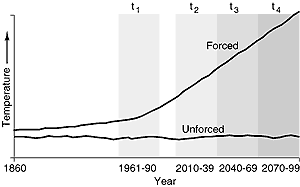13.3.3 Combining Baseline and Modelled Data

Figure 13.4: A schematic representation of different simulations
and periods in a coupled AOGCM climate change experiment that may be used
in the definition of modelled climate change. t1 to t4
define alternative 30-year periods from either forced or unforced experiments.
|
Climate scenarios based on model estimates of future climate
can be constructed either by adopting the direct model outputs or by combining
model estimates of the changed climate with observational climate data. Impact
studies rarely use GCM outputs directly because GCM biases are too great and
because the spatial resolution is generally too coarse to satisfy the data requirements
for estimating impacts. Mearns et al. (1997) and Mavromatis and Jones (1999)
provide two of the few examples of using climate model output directly as input
into an impact assessment.
Model-based estimates of climate change should be calculated with respect to
the chosen baseline. For example, it would be inappropriate to combine modelled
changes in climate calculated with respect to model year 1990 with an observed
baseline climate representing 1951 to 1980. Such an approach would “disregard”
about 0.15°C of mean global warming occurring between the mid-1970s and
1990. It would be equally misleading to apply modelled changes in climate calculated
with respect to an unforced (control) climate representing “pre-industrial”
conditions (e.g., “forced” t3 minus “unforced”
t1 in Figure 13.4) to an observed baseline
climate representing some period in the 20th century. Such an approach would
introduce an unwarranted amount of global climate change into the scenario.
This latter definition of modelled climate change was originally used in transient
climate change experiments to overcome problems associated with climate “drift”
in the coupled AOGCM simulations (Cubasch et al., 1992), but was not designed
to be used in conjunction with observed climate data. It is more appropriate
to define the modelled change in climate with respect to the same baseline period
that the observed climate data set is representing (e.g., “forced”
t3 minus “forced” t1 in Figure
13.4, added to a 1961 to 1990 baseline climate).
Whatever baseline period is selected, there are a number of ways in which changes
in climate can be calculated from model results and applied to baseline data.
For example, changes in climate can be calculated either as the difference or
as the ratio between the simulated future climate and the simulated baseline
climate. These differences or ratios are then applied to the observed baseline
climate – whether mean values, monthly or a daily time-series. Differences
are commonly applied to temperature (as in Box 13.1),
while ratios are usually used with those surface variables, such as precipitation,
vapour pressure and radiation, that are either positive or zero. Climate scenarios
have been constructed using both absolute and relative changes for precipitation.
The effects of the two different approaches on the resulting climate change
impacts depend on the types of impacts being studied and the region of application.
Some studies report noticeable differences in impacts (e.g., Alcamo et al.,
1998), especially since applying ratio changes alters the standard deviation
of the original series (Mearns et al., 1996); in others, differences in impacts
were negligible (e.g., Torn and Fried, 1992).
|